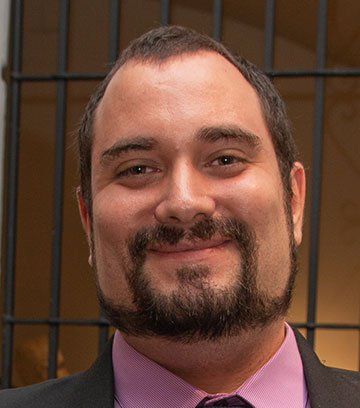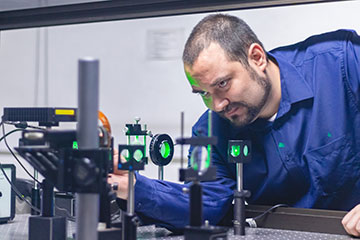
Alejandro Velez-Zea [Image: Dirección de Comunicaciones Universidad de Antioquia / Alejandra Uribe F.]
In the latest installment of Journeys in Optics, OPN spoke with Alejandro Velez-Zea, an assistant professor at the University of Antioquia, Colombia, where he previously received his bachelor’s degree. Velez-Zea attended the National University of La Plata, Argentina, for his Ph.D., which focused on optical encryption methods, digital holography and holographic displays. After Velez-Zea returned to his undergraduate institution as a professor, his work on augmented-reality holographic displays won the 2023 Optica Foundation Challenge prize, which he says was instrumental to the success of the project.
Can you tell us about your career journey up to this point?
During my undergraduate physics studies at the University of Antioquia, Colombia, I sought a field that offered opportunities for theoretical, computational and experimental work. I was reluctant to choose just one focus too early in my career due to my indecisiveness. However, most research groups at my university specialized in only one of these areas, with little opportunity to experience all three.
Later in my studies, an opportunity arose for an internship in the optics and photonics group at my university. This group had a longstanding collaboration with researchers in Argentina in optical information processing. I secured the internship and began working on optical cryptosystems. I thoroughly enjoyed the combination of experimental work on an optical table and the computer simulations required by this field.
Upon graduation, I pursued a Ph.D. in Argentina under Roberto Torroba, National University of La Plata, who had helped initiate the collaboration with my undergraduate university in the 1990s. My research focused on various optical encryption methods and experimental setups closely related to digital holography and holographic displays. This led to a natural progression where the methods we proposed for optical encryption were also applicable for enhancing digital holography and computer-generated holography, and vice versa.
As my experience grew and we gained access to better equipment, testing our holography methods with a holographic display—and subsequently improving these displays—became a logical next step.
What motivates you as a researcher?
For me, the process of solving specific problems within the boundaries of our theoretical and technical capabilities, and then bringing those solutions to fruition through experimental demonstration, has always been very satisfying. Initially, this was the main driving force behind my research. However, since becoming a professor, mentoring my own students has become an equally powerful motivation. Helping students learn to formulate new solutions and become capable of independent research is currently one of the main goals of my work.
What is something you feel proud of in your career?
The proudest moment in my career so far was seeing my first student graduate from the physics program at the University of Antioquia, where I am now a professor, and publish his first paper in an Optica journal, showcasing the fruits of his work from the past year and a half.

Alejandro Velez-Zea working in his lab. [Image: Dirección de Comunicaciones Universidad de Antioquia / Alejandra Uribe F.]
Can you tell us about your project that won an Optica Foundation Challenge prize, and your experience with the program?
My winning project is titled “Multilayer Holographic Augmented Reality with Digital Micromirror Devices: Content Pipeline and System Implementation.” The core purpose of this project is to design and implement an augmented-reality holographic display based on digital micromirror devices (DMDs), along with the computer-generated algorithms needed to produce content for this display.
A holographic display, at its most basic level, consists of a coherent light source and a spatial light modulator (SLM), which imparts the incoming light with the phase or amplitude characteristics encoded in a previously obtained hologram. Most recent holographic displays are based on phase-only spatial light modulation, which is generally very effective. However, the modulators used for phase-only modulation are very expensive.
DMDs, on the other hand, provide binary amplitude modulation. This approach is comparatively inefficient and presents significant challenges for hologram generation. However, DMDs have two key advantages: They are significantly cheaper and capable of extremely fast operation.
Our current results indicate that these advantages, when combined with adaptations of recent advancements in computer-generated holography to suit the characteristics of DMDs, can make these devices a viable, lower-cost alternative to phase modulators. This could lower the barrier to adoption of holographic display technologies, making them more accessible.
My experience with the Optica Foundation Challenge program has been excellent. Winning the grant enabled us to acquire equipment to test the computer-generated holography methods we are developing for use with DMDs. Additionally, it allowed me to fund the master's degree of a student who is deeply invested in this topic. Thanks to the support from the Optica Foundation, we have been able to be more ambitious with our research goals.
Overall, attempting to build a functional augmented-reality holographic display without the support of the Optica Foundation Challenge would have been very difficult. The program has provided invaluable resources and opportunities that have significantly advanced our work in this area.
Looking back, is there anything that you would have done differently along your career path?
I would have taken far greater care of my health. The continued focus on achieving research goals can be very fulfilling; however, it can lead to neglecting other aspects of one’s personal life, such as interpersonal relationships, exercise and mental wellbeing. As a young student, these sacrifices may seem minor, but as I have experienced, they can lead to significant issues down the line.
What do you think is the most important aspect of mentoring?
While I am new to being a mentor, I have found two factors to be very important: honesty and empathy. First, we must be transparent about the realities of work in our field and our current context. This means avoiding both overly optimistic portrayals and discouraging pessimism. Research is challenging and demanding and success is not guaranteed, but it can also be deeply fulfilling.
Second, we need to be understanding of the challenges and issues our mentees are facing. This does not mean excusing their shortcomings but rather attempting to empathize with their perspectives and acknowledging that the solutions that worked for us may not be the best for them. By fostering this understanding, we can establish a better working and mentoring relationship where issues can be addressed collaboratively as a team.
What advice would you give to students or early-career researchers?
First, take care of yourself physically and mentally. Next, learn not only about the topics you are researching but also about the people involved in that research. Understanding the context in which some research was conducted can provide valuable perspective on the challenges faced in your own work. This is also crucial when selecting a potential advisor or mentor, which is one of the most important choices in a student’s career.
Finally, constantly recalibrate your expectations based on the information you receive and prepare for setbacks. The measure of success and failure in research can vary depending on many factors, some of which are outside your control. Preparing for this variability is essential to help overcome the low points during your career.
